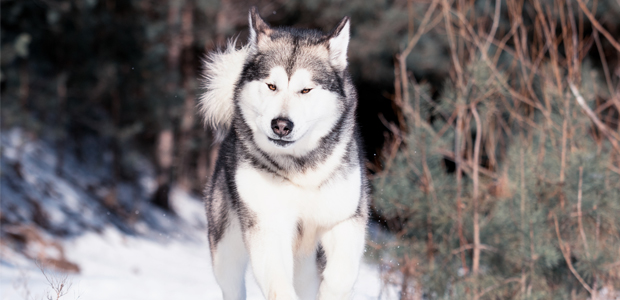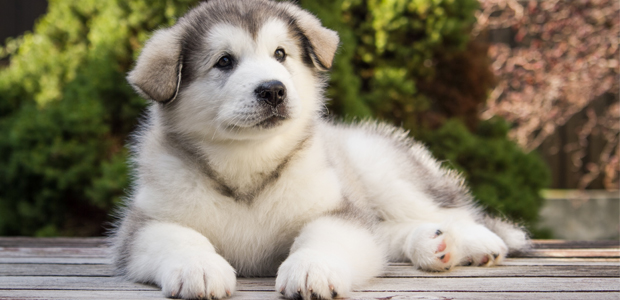The Alaskan Malamute: is it the right breed for you?
Wolfish in appearance, the Alaskan Malamute is an affectionate and cheeky dog. Often mistaken for the Siberian Husky, the Alaskan Malamute is taller and heavier.
Originally bred for pulling sledges, historians estimate that they originated in Alaska around 5,000 years ago, making them one of the oldest dog breeds on earth. Due to their exploratory nature, they love to run and need lots of exercise, at least 2 hours a day.
Alaskan Malamute summary:
- Active & friendly dogs who love the outdoors
- Thick “double coat”
- Variety of colours including white, black, piebald, silver, brown & red
- Average size = 58 - 65 cm
- Average weight = 30 - 40 kg
- Alaskan Malamute life expectancy = 10 - 14 years
- Estimated monthly cost = High
- Exercise needs = High
- Attention needs = Medium
- Sociability = Medium
Please note: A dog’s exercise, training/stimulation and grooming requirements can depend on several factors such as age and health. The same goes for ongoing costs of ownership. For advice on one specific dog, we always advise chatting with a vet.
How much exercise does an Alaskan Malamute need?
If you’re looking for a canine companion to join you on outdoor adventures, look no further than the Malamute! These dogs have bags of energy and will need a minimum of 2 lengthy walks per day.
Alaskan Malamutes are built for arctic climates and can suffer in warm weather – although they’ll still need their exercise. During summer, it’s important to walk your Malamute during cooler times of the day and if you live somewhere with a permanently warm climate, a Malamute may not be the breed for you.
Malamutes are natural escapologists and have a high prey drive, so it’s their natural instinct to chase after squirrels and rabbits. When you’re out walking, keep them on the lead until you reach a secure area… and always keep your eyes peeled.
As with all breeds, be careful not to over-exercise them whilst they are still growing, as this can have long term effects on their joints. As well as outdoor activities, Malamutes need to stay mentally stimulated with training and puzzle games.

Alaskan Malamute temperament, socialising and ideal home environment
Malamutes are social dogs that love to spend time with their family and other dogs. If you’re an experienced dog owner looking to welcome a second pooch to the family, a Malamute may be a great option.
Kind and caring, these gentle giants are suited to houses where they’ve got plenty of space and easy access to the outdoors. Because of their large stature, Malamutes require socialisation training as it’s vital that they learn how to behave around other dogs and unfamiliar people.
They might not make the best pet if you have young children, because of the risk of knocking them over. They are better suited to households with adults and older children who know how to play gently with them. As with all breeds, it’s recommended that children are supervised when playing with dogs.
Whilst they are still young and receptive, it's a good idea to introduce your Malamute to other dogs, people and livestock as well as car travel and unfamiliar noises, such as traffic.
They form strong bonds with their families and don’t like to be left alone for long periods, so if you’re out of the house for most of the day, this is something to bear in mind. It’s good practice to leave them on their own for small periods during training so that they can get used to being by themselves.
Training: how to train an Alaskan Malamute
It's important to start your Alaskan Malamute training when they’re young, ideally as soon as you bring them home.
Malamutes are very intelligent dogs; they can get bored quite quickly and resort to negative behaviour such as howling and chewing up your furniture. But this is easy enough to prevent!
Keep your Malamute’s training routine fun and varied so your dog’s mind stays engaged at all times. Add exercise to their routine with games such as fetch – Malamutes are working dogs and love to keep busy!
Malamutes will start to approach new experiences with caution when they are around 12 weeks old. Therefore, it’s really important for their development that they experience as many different situations as possible.
As with all breeds, always use positive reinforcement when training your Malamute and avoid raising your voice.

Grooming: do Alaskan Malamutes shed?
To keep them warm in arctic conditions, Malamutes have a “double coat”. This thick coat keeps them nice and toasty, but it does mean that they are heavy shedders, especially during spring and autumn.
Your Malamute will need brushing every few days. They’re naturally clean dogs and don’t have a strong odour, so you’ll only need to bathe your Malamute if they’re really dirty or if they’ve rolled through something smelly.
Complete your Malamute’s grooming routine with regular tooth brushing, nail clips and ear checks.
Cost of owning an Alaskan Malamute
When considering the lifetime cost of owning a Malamute, remember to take into account the following costs
- Food and dietary needs
- Veterinary care
- Pet insurance
- Kennels or dog sitters
- Regular Malamute grooming costs
- Toys and equipment
- Preventative healthcare
As a rough guide, allow between £100 and £150 a month to cover the ongoing costs of owning an Alaskan Malamutel. Our vets have drawn up this handy guide to save dog owners money.
Are Alaskan Malamutes prone to any health problems?
Malamutes are prone to certain health problems, just like all breeds. This doesn’t mean your dog is guaranteed to contract any particular disease – it’s just something to bear in mind.
To keep your Malamute as healthy as possible, monitor them closely and attend routine 6-monthly health checks with your vet.
This will allow the vet to give your dog a thorough check-up, and to pick up on minor (often symptomless) conditions before they have a chance to escalate into something worse.
Possible health complications for Malamutes Include:
- Canine dental issue and gum disease
- Infections
- Canine obesity and weight problems
- Allergies (including flea,food and pollen)
- Hip dysplasia
Before welcoming a new dog into your household, make sure you’re able to cover the costs of any routine or emergency medical treatment they may need. Pet insurance will help massively with this. Why not ask your vet about their recommended pet insurance policy?

Alaskan Malamute dietary requirements
Your Malamute will need a balanced diet rich in nutrients, vitamins, and minerals. It’s best to feed them complete dog food specially formulated for large breeds to ensure that they are getting the right amounts of vitamins and nutrients.
Growing pups may prefer 3-4 smaller servings during the day, rather than two larger meals. This can be reduced to two meals a day as your dog gets older.
The recommended portion size will depend on your individual dog. You’ll need to take into account their activity level, age and metabolism. To avoid weight gain, make sure your dog has a healthy and balanced diet and gets plenty of exercise.
For dietary advice that’s specific to your dog, have a chat with your local vet or the breeder you’re purchasing your puppy from.
Are Alaskan Malamutes suitable for first time owners?
Malamutes may not be the easiest companion, especially if you’re a first-time pet owner. They’re large dogs that can quickly become a handful if they’re not properly stimulated and socialised.
They enjoy human company and they need lots of exercise, so if you’re out of the house for most of the day, then they might not be the most suitable breed for you.
If you are able to give them the time and attention they need, owning a Malamute can be an enjoyable and rewarding experience.
Need more info?
For more info on finding the best dog breed for you and your lifestyle, have a chat with your vet. Find your nearest vet using our Find a Vet page.

